heating MITSUBISHI ECLIPSE CROSS 2020 (in English) Owner's Guide
[x] Cancel search | Manufacturer: MITSUBISHI, Model Year: 2020, Model line: ECLIPSE CROSS, Model: MITSUBISHI ECLIPSE CROSS 2020Pages: 427, PDF Size: 78.05 MB
Page 352 of 427
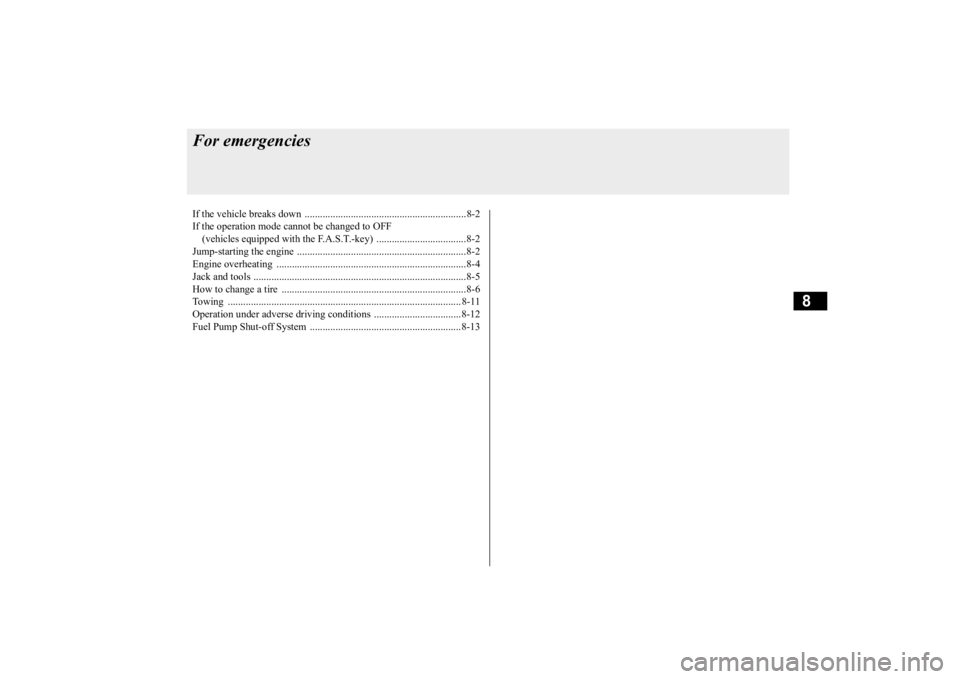
8
For emergenciesIf the vehicle breaks
down ...............................................................8-2
If the operation mode cannot be changed to OFF (vehicles equipped with the
F.A.S.T.-key) ...................................8-2
Jump-starting the engine
........................................
..........................8-2
Engine overheating .........
.................................................................8-4
Jack and tools ..................
.................................................................8-5
How to change a tire
..............................................
..........................8-6
Towing ................................................
........................................... 8-11
Operation under adverse driv
ing conditions ..................................8-12
Fuel Pump Shut-off Sy
stem ...........................................................8-13
BK0277700US.bo
ok 1 ページ 2019年3月8日 金曜日 午前9時23分
Page 355 of 427

Engine overheating 8-4 For emergencies
8
If you drive your vehicle with a low battery charge after the engine has been started by using jumper cables, the engine may misfire. This can cause the anti-lock braking systemwarning light to blink on and off. This is only due to the low battery voltage. It is not a problem with the brake system. If this hap-pens, fully charge the battery and ensure thecharging system is operating properly.
N00836501421
When the engine is overheating, the informa-tion screen in the multi-information display will be interrupted and the engine coolant temperature warning display will appear. Also “ ” will blink. If these warnings are displayed: 1. Stop the vehicle in a safe place. Turn on the hazard warning flashers.2. With the engine still running, carefully raise the engine hood to vent the engine compartment.
3. Check that the cooling fan is running. If the fan is not turning, stop the engine immediately and contact an authorized Mitsubishi Motors dealer or a repair facil-ity of your choice for assistance. 4. If you see steam or spray coming from under the hood, turn off the engine. 5. If you do not see steam or spray comingfrom under the hood, leave the engine on until the high coolant temperature warn- ing goes off. After the high coolant tem-perature warning has gone off, you can start driving again. If the high coolant temperature warning stays on, turn off theengine.
Charging the battery by using an external battery charger
WA R N I N G Always remove the battery from your vehicle when the battery is charged by anexternal battery charger. Keep sparks, cigarettes, and flames away from the battery because the battery could explode. Keep your work area well vented when charging or using the battery in an enclosed space. Remove all the caps before charging the battery. Electrolyte (battery acid) is made of corro- sive diluted sulfuric acid. If electrolytecomes in contact with your hands, eyes, clothes, or the painted surface of your vehicle, thoroughly flush with water. Ifelectrolyte gets in your eyes, flush them immediately and thoroughly with water, and get prompt medical attention. Always wear protective clothing and gog- gles when working near the battery. Keep the battery out of the reach of chil- dren.
As your vehicle has anti-lock brakes Engine overheating
WA R N I N G To avoid personal injury, keep hands, hair, jewelry and clothes away from the coolingfan. The cooling fan can start at any time.WA R N I N G Before raising the engine hood, check to see if there is steam or spray coming from under the hood. Steam or spray coming from an overheated engine could seriously scald you.Do not open the hood until there is no steam or spray.
BK0277700US.bo
ok 4 ページ 2019年3月8日 金曜日 午前9時23分
Page 363 of 427
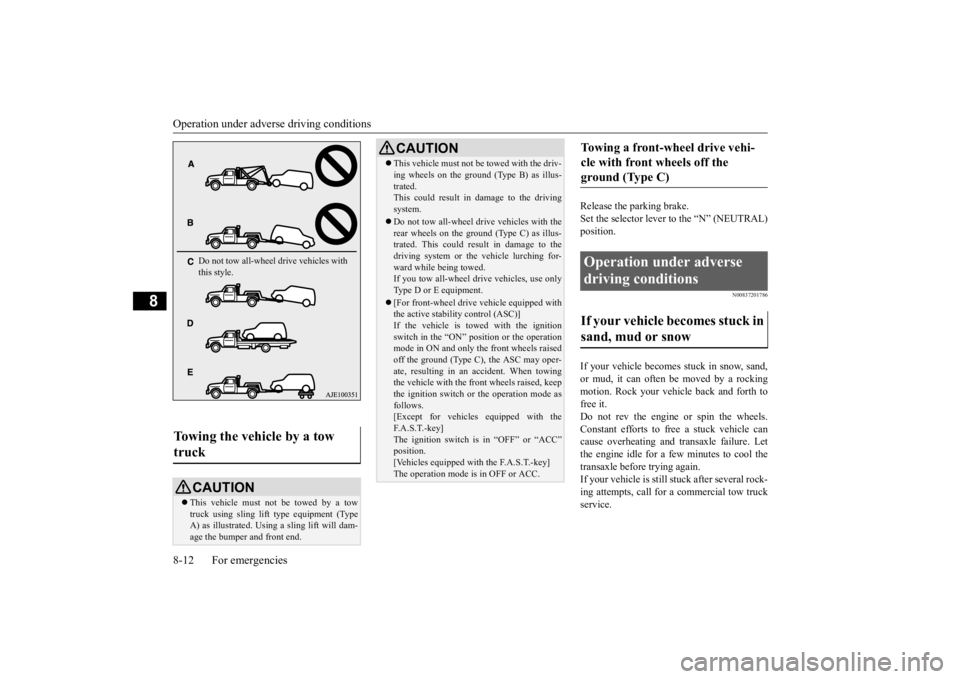
Operation under adverse driving conditions 8-12 For emergencies
8
Release the parking brake. Set the selector lever to the “N” (NEUTRAL) position.
N00837201786
If your vehicle becomes stuck in snow, sand,or mud, it can often be moved by a rocking motion. Rock your vehicle back and forth tofree it. Do not rev the engine or spin the wheels. Constant efforts to free a stuck vehicle cancause overheating and transaxle failure. Let the engine idle for a few minutes to cool the transaxle before trying again.If your vehicle is still stuck after several rock- ing attempts, call for a commercial tow truck service.
Towing the vehicle by a tow truck
CAUTION This vehicle must not be towed by a tow truck using sling lift type equipment (Type A) as illustrated. Using a sling lift will dam-age the bumper and front end.Do not tow all-wheel drive vehicles with this style.
This vehicle must not be towed with the driv- ing wheels on the ground
(Type B) as illus-
trated. This could result in damage to the driving system. Do not tow all-wheel drive vehicles with the rear wheels on the ground (Type C) as illus-trated. This could result in damage to the driving system or the vehicle lurching for- ward while being towed.If you tow all-wheel drive vehicles, use only Type D or E equipment. [For front-wheel drive vehicle equipped with the active stability control (ASC)] If the vehicle is towed with the ignitionswitch in the “ON” position or the operation mode in ON and only the front wheels raised off the ground (Type C), the ASC may oper-ate, resulting in an accident. When towing the vehicle with the front wheels raised, keep the ignition switch or the operation mode asfollows. [Except for vehicles equipped with the F. A . S . T. - k e y ]The ignition switch is in “OFF” or “ACC” position. [Vehicles equipped with the F.A.S.T.-key] The operation mode is in OFF or ACC.CAUTION
Towing a front-wheel drive vehi- cle with front wheels off the ground (Type C) Operation under adverse driving conditions If your vehicle becomes stuck in sand, mud or snow
BK0277700US.bo
ok 12 ページ 2019年3月8日 金曜日 午前9時23分
Page 368 of 427
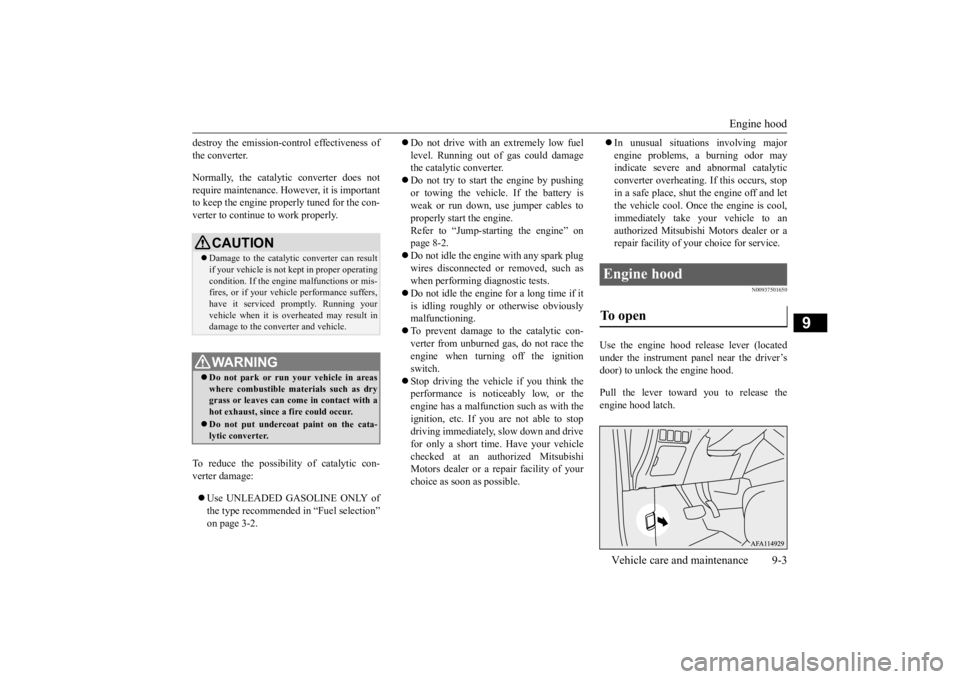
Engine hood
Vehicle care and maintenance 9-3
9
destroy the emission-control effectiveness of the converter. Normally, the catalytic converter does not require maintenance. However, it is important to keep the engine properly tuned for the con-verter to continue to work properly. To reduce the possibility of catalytic con- verter damage: Use UNLEADED GASOLINE ONLY of the type recommended in “Fuel selection” on page 3-2.
Do not drive with an extremely low fuel level. Running out of gas could damage the catalytic converter. Do not try to start the engine by pushing or towing the vehicle. If the battery is weak or run down, use jumper cables to properly start the engine.Refer to “Jump-starting the engine” on page 8-2. Do not idle the engine with any spark plug wires disconnected or removed, such aswhen performing diagnostic tests. Do not idle the engine for a long time if it is idling roughly or otherwise obviouslymalfunctioning. To prevent damage to the catalytic con- verter from unburned gas, do not race theengine when turning off the ignition switch. Stop driving the vehicle if you think the performance is noticeably low, or the engine has a malfunction such as with the ignition, etc. If you
are not able to stop
driving immediately, slow down and drive for only a short time. Have your vehicle checked at an authorized MitsubishiMotors dealer or a repair facility of your choice as soon as possible.
In unusual situations involving major engine problems, a burning odor may indicate severe and abnormal catalytic converter overheating. If this occurs, stopin a safe place, shut the engine off and let the vehicle cool. Once the engine is cool, immediately take your vehicle to anauthorized Mitsubishi Motors dealer or a repair facility of your choice for service.
N00937501650
Use the engine hood release lever (located under the instrument panel near the driver’s door) to unlock the engine hood. Pull the lever toward you to release the engine hood latch.
CAUTION Damage to the catalytic converter can result if your vehicle is not kept in proper operating condition. If the engine malfunctions or mis-fires, or if your vehicle performance suffers, have it serviced promptly. Running your vehicle when it is overheated may result indamage to the converter and vehicle.WA R N I N G Do not park or run your vehicle in areas where combustible materials such as drygrass or leaves can come in contact with a hot exhaust, since a fire could occur. Do not put undercoat paint on the cata- lytic converter.
Engine hood To open
BK0277700US.bo
ok 3 ページ 2019年3月8日 金曜日 午前9時23分
Page 387 of 427

For cold and snowy weather 9-22 Vehicle care and maintenance
9
N00941800093
Check the following parts for damage and grease leaks: Ball joint boots of the suspension and steering linkage Bellows on both ends of the drive shaft
N00942201118
The best way to keep carbon monoxide gas from entering inside your vehicle is to have the engine exhaust system properly serviced. Have a competent mechanic inspect the com-plete exhaust system and nearby body areas for broken, damaged, deteriorated, or mispo- sitioned parts if you notice any of the follow-ing: A change in the sound of the exhaust sys- tem The smell of exhaust fumes inside the vehicle
The underside or rear of the vehicle is damaged
Also check the exhaust system each time the vehicle is raised for lubrication, oil changes, or required service. Any open seams or looseconnections could let dangerous exhaust fumes seep into the luggage and passenger compartments. Check for holes or exhaust gas leaks caused by corrosion or damage. Check the joints and connections for looseness or exhaust gas leaks. Check the rubber hangers and brackets for damage.
N00942501124
The hood lock release mechanism and hood safety catch should be checked, cleaned, and oiled when needed for easy movement and toprevent rust and wear. Use Multipurpose Grease NLGI Grade 2 spar
ingly for all sliding
parts of the hood latch and release lever.Work the grease into the hood lock mecha-
nism until all the movable surfaces are cov- ered. Also, put a light coat of the same grease on the safety catch wherever moving parts touch.
N00942601141
The ventilation slots in front of the wind- shield should be brushed clear after a heavy snowfall so that the operation of the heatingand ventilation systems will not be impaired. To prevent freezing of the weatherstripping on the doors, engine hood, etc., they should be treated with silicone grease. It is a good idea to carry a shovel or a short- handled spade in the vehicle during the win- ter so that you can clear away snow if you get stranded. A small hand-brush for sweeping
Ball joint, steering linkage seals, drive shaft boots Exhaust system
WA R N I N G Carbon monoxide gas from your vehicle’s exhaust is poisonous. Breathing these fumes can cause unconsciousness or death.
Check for any of the following conditions: Hood lock release mechanism and safety catch
For cold and snowy weather Ventilation slots Weatherstripping Additional equipment (For regions where snow is encoun-tered)
BK0277700US.bo
ok 22 ページ 2019年3月8日 金曜日 午前9時23分
Page 421 of 427
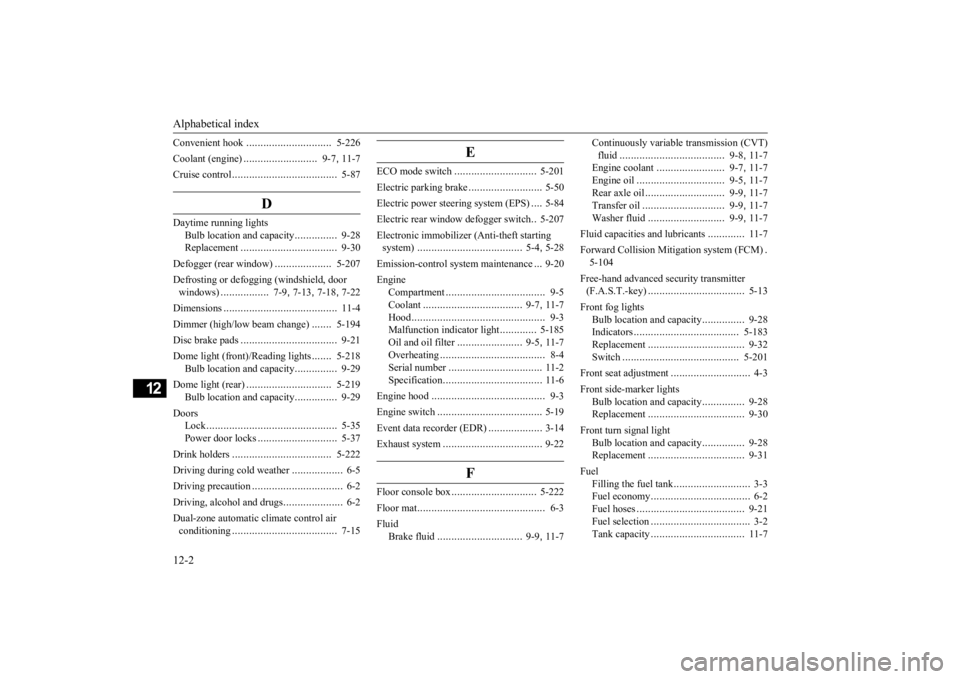
Alphabetical index 12-2
12
Convenient hook
...............
...............
5-226
Coolant (engine)
..........................
9-7
, 11-7
Cruise control
....................
.................
5-87
D
Daytime running lights
Bulb location and capacity
...............
9-28
Replacement
.................
.................
9-30
Defogger (rear window)
....................
5-207
Defrosting or defogging (windshield, door windows)
.................
7-9
, 7-13
, 7-18
, 7-22
Dimensions
...................
.....................
11-4
Dimmer (high/low beam change)
.......
5-194
Disc brake pads
.................
.................
9-21
Dome light (front)/Reading lights
.......
5-218
Bulb location and capacity
...............
9-29
Dome light (rear)
...............
...............
5-219
Bulb location and capacity
...............
9-29
Doors
Lock
......................
........................
5-35
Power door locks
............................
5-37
Drink holders
....................
...............
5-222
Driving during cold weather
..................
6-5
Driving precaution
................
................
6-2
Driving, alcohol and drugs
.....................
6-2
Dual-zone automatic climate control air conditioning
....................
.................
7-15
E
ECO mode switch
.............................
5-201
Electric parking brake
..........................
5-50
Electric power steering system (EPS)
....
5-84
Electric rear window defogger switch
..5-207
Electronic immobilizer (Anti-theft starting system)
.....................
................
5-4
, 5-28
Emission-control system maintenance
...
9-20
Engine
Compartment
..................
.................
9-5
Coolant
...................
................
9-7
, 11-7
Hood
.......................
........................
9-3
Malfunction indicator light
.............
5-185
Oil and oil filter
.......................
9-5
, 11-7
Overheating
....................
.................
8-4
Serial number
.................
................
11-2
Specification
...................
................
11-6
Engine hood
....................
....................
9-3
Engine switch
.....................
................
5-19
Event data recorder (EDR)
...................
3-14
Exhaust system
...................
................
9-22
F
Floor console box
..............................
5-222
Floor mat
.........................
....................
6-3
Fluid
Brake fluid
..............................
9-9
, 11-7
Continuously variable transmission (CVT) fluid
....................
.................
9-8
, 11-7
Engine coolant
........................
9-7
, 11-7
Engine oil
...............................
9-5
, 11-7
Rear axle oil
............................
9-9
, 11-7
Transfer oil
.............................
9-9
, 11-7
Washer fluid
...........................
9-9
, 11-7
Fluid capacities and lubricants
.............
11-7
Forward Collision Mitigation system (FCM)
.
5-104 Free-hand advanced security transmitter (F.A.S.T.-key)
.................
.................
5-13
Front fog lights
Bulb location and capacity
...............
9-28
Indicators
..................
...................
5-183
Replacement
.................
.................
9-32
Switch
......................
...................
5-201
Front seat adjustment
............................
4-3
Front side-marker lights
Bulb location and capacity
...............
9-28
Replacement
.................
.................
9-30
Front turn signal light
Bulb location and capacity
...............
9-28
Replacement
.................
.................
9-31
Fuel
Filling the fuel tank
...........................
3-3
Fuel economy
...................
................
6-2
Fuel hoses
.....................
.................
9-21
Fuel selection
...................
................
3-2
Tank capacity
................
.................
11-7
BK0277700US.bo
ok 2 ページ 2019年3月8日 金曜日 午前9時23分
Page 423 of 427
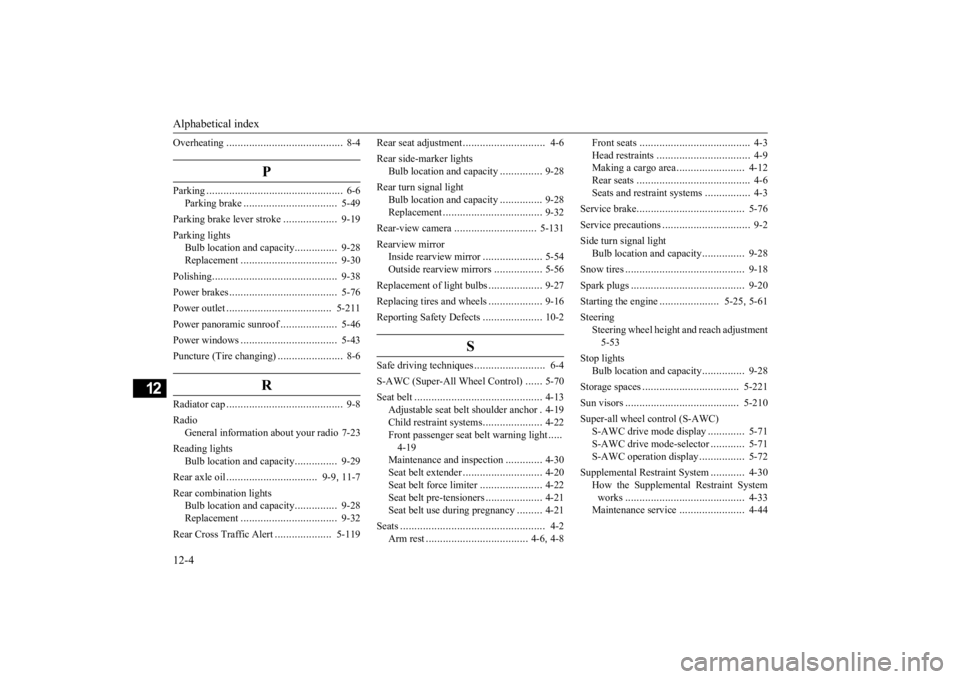
Alphabetical index 12-4
12
Overheating
......................
...................
8-4
P
Parking
.........................
.......................
6-6
Parking brake
................
.................
5-49
Parking brake lever stroke
...................
9-19
Parking lights
Bulb location and capacity
...............
9-28
Replacement
.................
.................
9-30
Polishing
.......................
.....................
9-38
Power brakes
.....................
.................
5-76
Power outlet
..................
...................
5-211
Power panoramic sunroof
....................
5-46
Power windows
.................
.................
5-43
Puncture (Tire changing)
.......................
8-6
R
Radiator cap
......................
...................
9-8
Radio
General information about your radio 7-23
Reading lights
Bulb location and capacity
...............
9-29
Rear axle oil
...............
.................
9-9
, 11-7
Rear combination lights
Bulb location and capacity
...............
9-28
Replacement
.................
.................
9-32
Rear Cross Traffic Alert
....................
5-119
Rear seat adjustment
.............................
4-6
Rear side-marker lights
Bulb location and capacity
...............
9-28
Rear turn signal light
Bulb location and capacity
...............
9-28
Replacement
...................
................
9-32
Rear-view camera
.............................
5-131
Rearview mirror
Inside rearview mirror
.....................
5-54
Outside rearview mirrors
.................
5-56
Replacement of light bulbs
...................
9-27
Replacing tires and wheels
...................
9-16
Reporting Safety Defects
.....................
10-2
S
Safe driving techniques
.........................
6-4
S-AWC (Super-All Wheel Control)
......
5-70
Seat belt
......................
.......................
4-13
Adjustable seat belt shoulder anchor
.4-19
Child restraint systems
.....................
4-22
Front passenger seat belt warning light
.....
4-19 Maintenance and inspection
.............
4-30
Seat belt extender
............................
4-20
Seat belt force limiter
......................
4-22
Seat belt pre-tensioners
....................
4-21
Seat belt use during pregnancy
.........
4-21
Seats
...........................
........................
4-2
Arm rest
..................
..................
4-6
, 4-8
Front seats
....................
...................
4-3
Head restraints
.................
................
4-9
Making a cargo area
........................
4-12
Rear seats
.....................
...................
4-6
Seats and restraint systems
................
4-3
Service brake
.....................
.................
5-76
Service precautions
...............
................
9-2
Side turn signal light
Bulb location and capacity
...............
9-28
Snow tires
.....................
.....................
9-18
Spark plugs
...................
.....................
9-20
Starting the engine
.....................
5-25
, 5-61
Steering
Steering wheel height and reach adjustment5-53
Stop lights
Bulb location and capacity
...............
9-28
Storage spaces
...................
...............
5-221
Sun visors
.....................
...................
5-210
Super-all wheel control (S-AWC)
S-AWC drive mode display
.............
5-71
S-AWC drive mode-selector
............
5-71
S-AWC operation display
................
5-72
Supplemental Restraint System
............
4-30
How the Supplemental Restraint System works
.....................
.....................
4-33
Maintenance service
.......................
4-44
BK0277700US.bo
ok 4 ページ 2019年3月8日 金曜日 午前9時23分